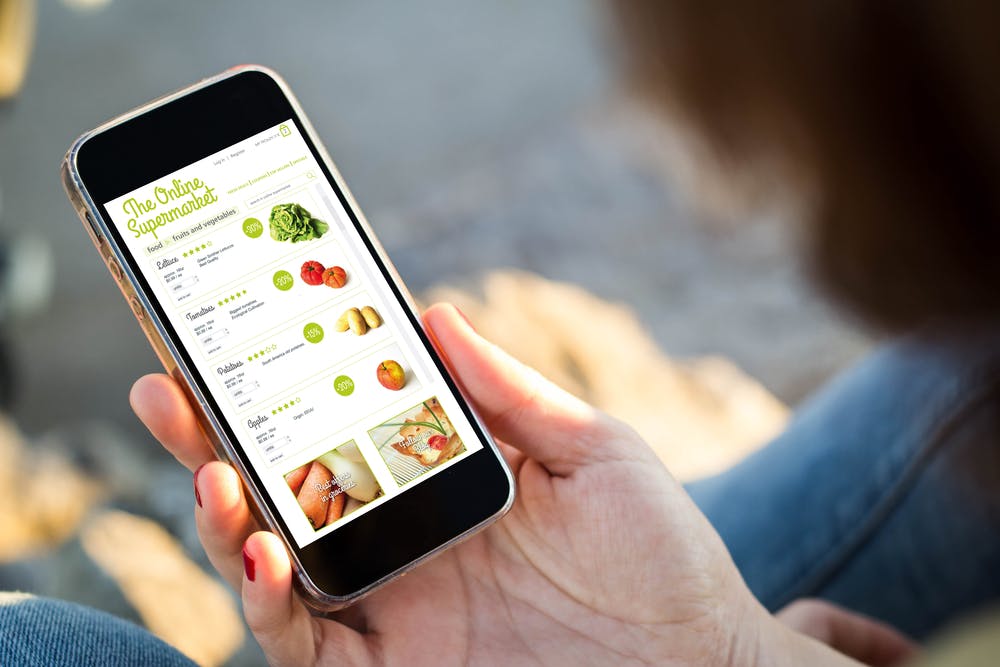Many of our day-to-day habits have changed since the start of the coronavirus pandemic, but the way consumers shop for food and groceries has undoubtedly been one of the biggest shifts.
As consumers visit supermarkets less frequently, it appears they are shopping online more often. In the US, Nielsen data shows that online sales of consumer packaged goods grew 56% for the week ending April 18th compared to the same period a year earlier. Within the CPG category, online sales of food were up 69.5% year-over-year for the week ending April 18th. Meanwhile, according to Nielsen, online accounted for 10% of all UK grocery sales for the four weeks ending 18th April – up from 7.5% at the end of 2019.
Mintel forecasts a 33% bump for online grocery sales in 2020 (and notes that 36% of UK consumers say they are increasing the amount of online shopping they do), while GlobalData predicts a 25.5% increase this year.
Will these forecasts prove accurate? Will new habits stick when life eventually returns to normal, and what could this mean for ecommerce?
Let’s look at the situation in more detail…
We are shopping less often but spending more
In March, as the coronavirus pandemic started to spread, supermarkets saw a huge spike in sales due to stockpiling. To prevent certain products from becoming sold out too quickly – such as toilet paper, eggs, and pasta – supermarkets enforced strict limitations on how many items customers could buy at any one time. While this sort of behaviour has since eased, the grocery sector is still seeing increased sales. According to recent figures from Kantar, UK grocery sales grew by 9.1% in the 12 weeks to April 19th, with an extra £524m spent on groceries in April, year-on-year.
Tesco’s chief executive, Dave Lewis, highlights how customer’s shopping behaviour has shifted to lower frequency but higher spend, suggesting that it could stay this way in future if people continue to be concerned about food supply chains. This could be the case, but it could also be that as consumers find benefits in new or different ways of shopping, they will naturally continue.
Speaking to the BBC, Lewis suggested that the number of Tesco transactions in April nearly halved, but the size of the average basket had doubled. He stated: “People are shopping once a week, a little like they did 10 or 15 years ago, rather than two, three or four times a week that was happening before the crisis.” This mirrors data from Kantar, which found that British households shopped 14 times for groceries during April, which is down from a previous average of 17.
Interestingly, this increase in shopping visits has been suggested as the real reason for lack of product availability at the start of the pandemic, which was initially blamed on consumers unnecessarily ‘stockpiling’. A study by Which? found that the average UK household spent an extra £62.92 during the four weeks to 22nd March, which equates to five extra days’ worth of groceries. With people working from home, children being out of school, and restaurants closed – it was always likely more consumption would occur at home. Similarly, with online deliveries in high demand and long queues at supermarkets, it also makes sense that consumers are now buying much more at one time, to save time and effectively social distance.
Tesco’s Clubcard system already seeks to encourage this ‘big shop’ behaviour and generate bigger orders. Launched last year, Clubcard Plus offers customers 10% off two big shops worth up to £200 in-store every month for a £7.99 subscription fee. While it is also only applicable for in-store shopping, usage of the Clubcard Plus mobile app may also help to drive interest in the supermarket’s separate ecommerce app, as customers adapt to mobile usage.
As a result of customers buying more, supermarkets have found themselves under increased pressure to maintain stock levels. In order to relieve this, some supermarkets including Sainsbury’s and Ocado stopped accepting new online customers in early March. This is still in place for Ocado, but Sainsbury’s now appears to be taking on new customers again. Overall, however, supermarkets have caught up on demand, and are now promoting successful online and offline operations. The main UK grocery retailers release weekly updates on how they are working to do so.
As we work to feed the nation and keep our colleagues and our customers safe, we have temporarily changed some of our processes. Read the full letter from our CEO here: https://t.co/yog8plcXUX pic.twitter.com/IpLcyDomeJ
— Sainsbury’s (@sainsburys) April 23, 2020
How will ecommerce adapt?
With social distancing likely to stay the norm indefinitely, customers who are currently shopping online could continue to do so for the foreseeable future, with this behaviour potentially turning into a habit long-term. Sainsbury’s CEO Mike Coupe said in a recent earnings call, “When people get into the habit of ordering their groceries online it’s likely to be sticky.”
Of course, this does depend on the experience that customers receive, meaning it is key that grocery retailers step up to the plate in delivering a valuable online customer experience (and to not just expect the demand to continue on the back of recent lifestyle changes).
It’s also the case that customers are currently more forgiving than they perhaps previously were, with the understanding that deliveries might take longer or that not all items will be available on demand. With that said, there has still been some criticism of supermarkets’ ability to scale up. Most supermarkets have continued to expand capacity on a regular basis; Tesco has just announced that it will increase its volume of delivery slots to reach 1.2 million customers in the coming weeks, which is double the amount it released at the start of the pandemic. However, Tesco’s announcement comes on the back of clear outstanding demand, with a high proportion of customers still unable to secure slots. This is one part of the customer experience that will be integral going forward, along with other factors such as item availability.
Understandably, these issues are due to supermarkets and grocery retailers coming under intense pressure in recent weeks, and many have increased their workforces in order to help meet the demand. In the US, Walmart announced it was hiring 200,000 additional workers, while Tesco in the UK hired a further 45,000. These are just two examples; most supermarkets increased the amount of staff at the height of the pandemic.
We’ve added more than 200,000 people to our workforce since last month. And today, we paid nearly $180 million in quarterly bonuses to our hourly associates early. Read more here: https://t.co/xTJ68Mo1To pic.twitter.com/jeUe5yzYGp
— Walmart Inc. (@WalmartInc) April 30, 2020
There is a question of how and if this operational level will be sustained long-term. Tesco has since laid off many of its temporary workers, however it’s been reported that this was always going to be the case when stockpiling eased, and that contracts were only set for a period of 12 weeks. In light of this, it will be vital for Tesco and other supermarkets to keep standards – particularly when it comes to delivery – at the same level or even better going forward.
At the same time, we could also see supermarkets continue to adapt and evolve the way they operate. Another development has been some grocery retailers (who were previously resistant to ecommerce) investing in online operations, and now offering shoppers the chance to buy grocery products online. Prior to the pandemic, Aldi only sold wine online, for example, but it has now expanded to online groceries with an ‘essentials’ box for people self-isolating. It will be interesting to see whether it expands its ecommerce capabilities in future. Elsewhere, wholesale retailers are expanding into direct-to-consumer, delivering produce directly to consumers (rather than supplying restaurants, or grocery stores that are only selling limited items). And supermarkets are also partnering with food delivery apps; Morrisons and Marks and Spencer have each teamed up with Deliveroo to offer customers an on-demand service of a limited range of items, which can be delivered in just 30 minutes.
Another shift could be towards ‘curbside pickups’, which is a service that is seeing traction in the US. It’s typically the same as ‘click and collect’ for grocery retailers in the UK. This involves ordering groceries online and driving by the store to have them loaded into the car for you. Unlike in-store shopping, curbside pickup allows for even greater convenience and complies with social distancing measures. According to Adobe Analytics, the number of orders placed online and picked up at bricks-and-mortar stores grew 208% between the 1st and 20th April compared to a year ago. In some states such as Texas, this service has started to be implemented as part of retail stores’ phased return to business, with some non-essential stores now allowing customers to pick up online orders in-person. For a big grocery stores like Walmart, the service has enabled it to meet online demand, with customers who are unable to book delivery slots choosing the option instead.
With supermarkets now looking for ways to enforce and improve social distancing measures for when lockdown restrictions are lifted, we could see more of an emphasis (or implementation) of these kinds of services. Increased safety, combined with even greater convenience, could encourage even more customers to think about shopping for groceries online.
Finally, of course, there is the question of whether additional services and increased labour will result in profit losses. Tesco has estimated a loss of up to $925 million from unmitigated costs throughout the pandemic. Similarly, Sainsbury’s predicted a £500m profit loss for the year, despite seeing a big surge in grocery sales. Chief Executive Mike Coupe has cited sick pay, the implementation of social distancing, and a fall in clothing sales as reasons for the profit hit.
Of course, labour costs of picking orders in store for click and collect or delivering to homes are high. If this trend is to continue, all the big supermarkets will be looking to optimise and automate their operations further where possible.
It’s easy to look to China as an example of innovation, where Alibaba’s Freshippo receives half of its orders for local delivery and uses automation to help assemble these orders.
Finally made it to a Hema (Freshippo). Online orders getting sent to fulfilment on an overhead conveyor belt. pic.twitter.com/5Qm1IQl5Pi
— Philip Wiggenraad (@philforsure) June 3, 2019
During lockdown, Freshippo has also been meeting the increased demand from coronavirus by launching group-buying schemes. These may not be viable ways for UK supermarkets to cut down on costs, but they certainly illustrate how increasing demand for online groceries may impact local fulfilment.
In the short-term, supermarkets in the west will be doing all they can to improve their digital and delivery infrastructure, hoping that impressive forecasts for online will help them take more of their market.








